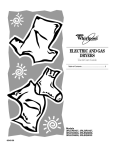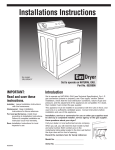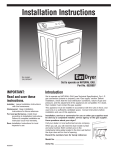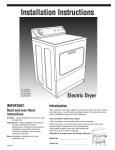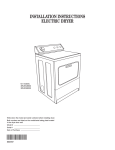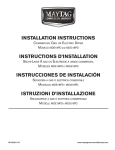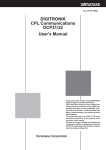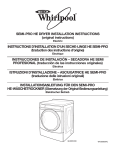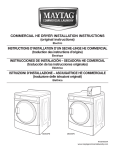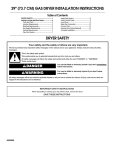Download Whirlpool 3RLEQ8000 Specifications
Transcript
Installation Instructions for models: 3RLER5437 3RLEQ8000 3RLEC8646 Electric Dryer IMPORTANT: Read and save these instructions. Introduction Installer: Leave Installation Instructions with homeowner. Homeowner: Keep Installation Instructions for future reference. For best performance, install dryer according to Installation Instructions. Failure to complete installation as instructed could void warranty. Save Installation Instructions for local inspector’s use. Have questions about your dryer? Call your dealer or local authorised service company. When you call, you will need the dryer model number and serial number. Both numbers are on the model/serial rating plate located in the door well behind the dryer door and on front of opening. Record the numbers here for handy reference: This appliance must be installed in accordance with the rules in force, and used only in a sufficiently ventilated space. Consult instructions before installation and use of this appliance. Model No. Serial No. 8528094 Before you start... Your safety and the safety of others are very important. We have provided many important safety messages in this manual and on your appliance. Always read and obey all safety messages. This is the safety alert symbol. This symbol alerts you to potential hazards that can kill or hurt you and others. All safety messages will follow the safety alert symbol and either the word “DANGER” or “WARNING”. These words mean: DANGER You can be killed or seriously injured if you don’t immediately follow instructions. WARNING You can be killed or seriously injured if you don’t follow instructions. All safety messages will tell you what the potential hazard is, tell you how to reduce the chance of injury, and tell you what can happen if the instructions are not followed. WARNING: If the information in this manual is not followed exactly, a fire or explosion may result causing property damage, personal injury or death. Do Not store or use gasoline, or other flammable vapours and liquids in the vicinity of this or any other appliance. 2 Tools and materials needed for installation... • level • gloves • 20 to 30 cm (8" or l0") adjustable wrench that opens to 2.5 cm (1") • flat-blade screwdriver • safety glasses • 1/4" nut driver or socket wrench • caulking gun and compound • knife • duct tape • 1" hex-head socket wrench • tin snips Parts supplied for installation... Remove parts package from dryer drum. Check that all parts were included. Venting Vent system 100 mm (4") metal exhaust vent must be used. WARNING Fire Hazard Use a heavy metal vent. Do not use a plastic vent. Do not use a metal foil vent. Failure to follow these instructions can result in death or fire. Exhaust hood Do Not use exhaust hoods with magnetic latches. Preferred Acceptable 4 leveling legs Parts needed for installation... Check local codes, and read electrical and venting requirements before purchasing parts. 10,2 cm (4") 10,2 cm (4") 6,4 cm (2-1/2") Floors sloped greater than 2.5 cm (1 inch): Require Extended Dryer Feet Kit, Part No. 279810 available for purchase from your dealer. Dryer location and dimensions Dimensions shown with feet extended 2.5 cm (1") from bottom of dryer. 27.9 cm (11") terminal block cover power supply cord/cable strain relief WARNING 35.6 cm (14") The dryer door extends 35.6 cm (14") from the front of the dryer when fully opened. 109.5 cm (43-1/8") Explosion Hazard Keep flammable materials and vapors, such as gasoline, away from dryer. Place dryer at least 45.7 cm (18 inches) above the floor for a garage installation. Failure to do so can result in death, explosion, or fire. For proper drying performance: The location must provide: • Protection from weather and water: Do not store or use dryer where it will be exposed to water and weather. • Room temperature above 7°C (45°F): If room temperature is below 7°C (45°F), automatic cycles may not shut off. • Level floor: Maximum slope under entire dryer should not be more than 2.5 cm (I inch). If slope is greater than 2.5 cm (1 inch), install Extended Dryer Feet Kit, Part No. 2798l0. Clothes may not tumble properly and automatic sensor cycles may not operate correctly if dryer is not level. • Sturdy floor to support dryer weight of 79.4 kg (175 pounds). • Air supply: It is important to make sure the room has an adequate air supply for drying operation. The operation of this appliance may affect the operation of other gas appliances which take their air supply for safe combustion from the same room. If in doubt consult the appliance manufacturers. • Exhaust to outdoors: Dryer must be exhausted outdoors to prevent large amounts of lint and moisture from accumulating and to maintain drying efficiency. 97.2 cm (38-1/4") 74.3 cm (29-1/4") 68.6 cm (27") Exhaust dimensions left or right side exhaust back exhaust 10.2 cm (4") 35.9 cm (14-1/8") It is the installer's responsibility to: • Observe all governing codes and ordinances. • Check code requirements: Some codes limit or do not permit installation of clothes dryers in garages, closets, mobile homes or sleeping quarters. Contact your local building inspector. • Comply with the installation specifications and dimensions. 10.8 cm (4-1/4") 26 cm (10-1/4") • Consider spacing requirements for companion appliances. • Properly install dryer. • Check that you have everything necessary; for proper installation. • Contact a competent installer to ensure that the electrical installation meets all national and local codes and ordinances. This installation must also conform with all national and local codes and ordinances. 3 Door clearance 57.8 cm (22-3/4") Exhaust requirements 9.8 cm (3-7/8") WARNING 48.9 cm (19-1/8") 57.8 cm (22-3/4") Location must be large enough to fully open dryer door. Electrical requirements Important: Observe all governing codes and ordinances. This dryer is supplied without an electric cord and plug. It must be connected by a competent electrician to a single-phase electricity supply at the voltage shown on the dataplate, using a suitable fixed wiring installation in accordance with local and national wiring regulations. A 3-wire circular cord of minimum conductor size 2.5mm 2 cross-section area should be used. A 30A supply fuse should be used, and a switch with a minimum contact separation of 3mm in both poles must be incorporated into the fixed wiring for dryer disconnection. A cord clamp bush is provided on the dryer, and should be tightened on completion of wiring. The electrical mains terminals are located behind the small rear access panel (terminal block cover), and connections should be made in accordance with the terminal markings. Remember to replace the terminal access panel (terminal block cover). If codes permit and an additional earth bond wire is used, it is recommended that a competent electrician determine that the earth bond path is adequate. 4 Fire Hazard Use a heavy metal vent. Do not use a plastic vent. Do not use a metal foil vent. Failure to follow these instructions can result in death or fire. • Do Not use non-metal flexible vent, metal vent that is smaller than 100 mm (4") in diameter or exhaust hoods with magnetic latches. • Do Not exhaust dryer into a chimney, furnace, cold air vent, attic or crawl space, or any other vent used for venting. • Do Not install flexible vent in enclosed walls, ceilings or floors. Important: Observe all governing codes and ordinances. Exhaust your dryer to the outside. Moisture and lint indoors may cause: • Lint to gather around the dryer where it can be fuel for a fire. • Moisture damage to woodwork, furniture, paint, wallpaper, carpet etc. • Housecleaning problems and health problems. 10 cm (four-inch) diameter vent is required for best performance. Rigid or flexible metal exhaust vent must be used. Do Not use a plastic or a foil vent. Rigid metal vent is recommended to prevent crushing and kinking. Flexible metal vent must be fully extended and supported when the dryer is in its final position. Remove excess flexible vent to avoid sagging and kinking that may result in reduced air flow. An exhaust hood should cap the exhaust vent to prevent exhausted air from returning to the dryer. Exhaust outlet hood must be at least 30.5 30.5 cm (12") min. cm (12 inches) from the ground or any object that may be in the path of the exhaust (such as flowers, rocks or bushes, etc.). If using an existing exhaust system clean lint from entire length of system and make sure exhaust hood is not plugged with lint. Replace any plastic or foil vent with rigid metal or flexible metal vent. Use 100 mm (4") clamps to seal all joints. Do Not use screws to secure vent. Service check: Back pressure in any exhaust system used must not exceed 15.2 mm (0.6 inches) in water column measured with an incline manometer at the point that exhaust vent connects to dryer. Plan the exhaust vent installation Determine vent length Preferred — 10.2 cm (4") 10.2 cm (4") When you have a 10.2 cm (4") hood Maximum length of 10.2 cm (4") diameter metal vent Number of Rigid 90° elbows 0 15.8 m (52 ft.) 1 13.4 m (44 ft.) 2 11.0 m (36 ft.) 3 8.2 m (27 ft.) 4 6.1 m (20 ft.) Flexible (fully extended) 9.4 m (31 ft.) 7.9 m (26 ft.) 6.7 m (22 ft.) 6.1 m (20 ft.) 5.5 m (18 ft.) Acceptable — Route the vent The exhaust outlet is located at the centre of the rear of the dryer. The exhaust vent can be routed up down, left, right or straight out the back of the dryer. 6.4 cm (2-1/2") When you have a 6.4 cm (2-1/2") hood Maximum length of 6.4 cm (2-1/2") diameter metal vent The design of the flue system should ensure that any condensate formed when operating the appliance from cold, is either retained and subsequently evaporated or discharged. Following these installation instructions should adequately meet this requirement. Select the route that will provide the straightest and most direct path outdoors. Plan the installation to use the fewest number of elbows and turns. Avoid making 90° turns. Number of Rigid 90° elbows 0 13.4 m (44 ft.) 1 11.0 m (36 ft.) 2 8.5 m (28 ft.) 3 6.4 m (21 ft.) 4 4.3 m (14 ft.) Flexible (fully extended) 7.0 m (23 ft.) 5.5 m (18 ft.) 4.3 m (14 ft.) 3.7 m (12 ft.) 3.0 m (10 ft.) 1. See the exhaust vent length chart that matches your type hood for the maximum vent lengths you can use. Do not use vent runs longer than specified in exhaust vent length charts. Exhaust Systems longer than specified will: – Accumulate lint creating a potential fire hazard. – Shorten the life of the dryer. – Reduce performance, resulting in longer drying times and increased energy usage. 2. Determine the number of elbows you will need. 3. In the column listing the type of metal vent you are using (rigid or flexible), find the maximum length of metal vent on the same line as the number of elbows. The maximum length using a 5.1 cm x 15.2 cm (2" x 6") rectangular vent with 2 elbows and a 6.4 cm (2-1/2") exhaust hood is 2.4 m (8 ft.). For exhaust systems not covered by exhaust vent length charts (such as multiple unit hookups, plenums, and power-assist fans), see Service Manual. Part No. 603197. (To purchase the Service Manual, contact your local authorised service company) The maximum length of the exhaust system depends upon: • the type of vent (rigid or flexible metal). • the number of elbows used. exhaust air flow better good When using elbows or making turns, allow as much room as possible. Bend vent gradually to avoid kinking. 5 Now start installation B. Prepare If installing washer and dryer, install dryer first. A. Install vent system (new installation) 1. Put on safety glasses and gloves. 2. Install exhaust dryer WARNING Excessive Weight Hazard Use two or more people to move and install dryer. Failure to do so can result in back or other injury. hood. Use caulking compound to seal exterior wall opening around exhaust hood. 3. Connect exhaust vent to hood with 100 mm (4”) clamp. (Exhaust vent MUST fit inside hood.) 4. Run exhaust vent to dryer location. Use the straightest path possible. Avoid 90° turns. Use 100 mm (4") clamps to secure vent pieces. Tin snips may be needed to cut vent to required length. 1. Open dryer door and remove drying rack, if included. Wipe drum with damp cloth to remove any dust. 2. Take two cardboard corners from dryer carton and place them on floor in back of dryer. Firmly grasp body of dryer and gently lay it on its back on the cardboard corners. diamond marking 3. Start to screw legs into holes by hand. Use an adjustable wrench or 2.5 cm (1") hex-head socket wrench to finish turning legs until you reach the ridge with the diamond marking. 4. Stand dryer up on cardboard or hardboard. 6 C. Electrical connection WARNING Fire Hazard This dryer must be earthed. Securely tighten all electrical connections. Failure to do so can result in death, fire, or electrical shock. This is a 3-wire appliance which must be earthed. For dryers supplied without an electric cord and plug, it must be connected by a competent electrician to a singlephase electricity supply at the voltage shown on the dataplate, using a suitable fixed wiring installation in accordance with local and national wiring regulations. A 3-wire circular cord of minimum conductor size 2.5 mm 2 cross-section area should be used. A 30A supply fuse should be used, and a switch with a minimum contact separation of 3 mm in both poles must be incorporated into the fixed wiring for dryer disconnection. A cord clamp bush is provided on the dryer, and should be tightened on completion of wiring. The electrical mains terminals are located behind the small rear access panel (terminal block cover), and connections should be made in accordance with the terminal markings. Remember to replace the terminal access panel (terminal block cover). Important: Observe all governing codes and ordinances. If codes permit and an additional earth bond wire is used, it is recommended that a competent electrician determine that the earth bond path is adequate. D. Level dryer Dryer must be level to reduce noise and assure proper performance. Slide dryer onto cardboard or hardboard before moving across floor to prevent floor damage. E. Exhaust dryer F. Check operation 10.2 cm (4") clamp 1. Check that you: 10.2 cm (4") clamp 1. Move dryer close to its permanent location. Leave enough room to connect exhaust vent. Remove cardboard or hardboard from under dryer. with 100 mm (4") clamps. ✔ have all the tools you started with. 1. Connect vent to dryer outlet using 100 mm (4") clamp. If connecting to existing vent, make sure the vent is clean. The vent must fit over the dryer outlet and inside the exhaust hood. 2. Check levelness of dryer by placing a level on top of dryer, first side to side, then front to back. If dryer is not level, adjust dryer legs up or down. If legs are not long enough to level dryer, order Extended Dryer Feet Kit, Part No. 2798I0 (sold two legs per kit), from your dealer. Technical specification (see rating plate in door opening for full model details) 220-240V ~ 50 Hz, 1ph 4575W, IPX4 Clothes capacity: 9.1 kg max. ✔ did not skip any steps. ✔ installed all parts. ✔ properly installed dryer legs. ✔ levelled dryer. ✔ have secured all exhaust vent joints 2. Move dryer into final position. Do not crush or kink exhaust vent. Make sure dryer is level. 2. Read the Use and Care Guide to fully understand your new dryer. 3. Connect electricity power supply. 4. Select a full heat cycle (not the air cycle) and start dryer. After five minutes, open dryer door. You should feel heat inside dryer or on the exhaust vent. If dryer makes an unusual noise, check that dryer is level. Moving dryer to a new location? Check with a licensed electrician to confirm that supply voltage at new home matches voltage specified on the model/serial rating plate. Shut off electrical supply to dryer. Disconnect power supply cable from dryer. Tape top to cabinet. Tape door to front panel. Turn leveling legs all the way in. Slide dryer onto cardboard or hardboard before moving it across the floor to prevent damaging floor covering. 7 Part No. 8528094 © 2000 Whirlpool Corporation Benton Harbor, Michigan 49022, U.S.A. Printed in U.S.A.








